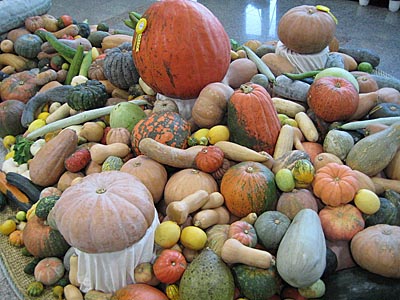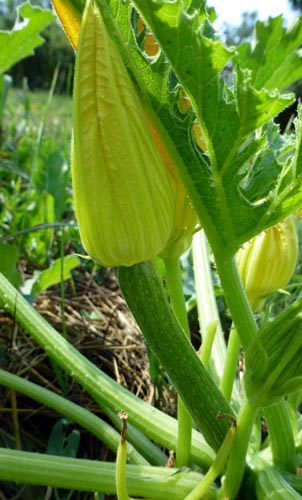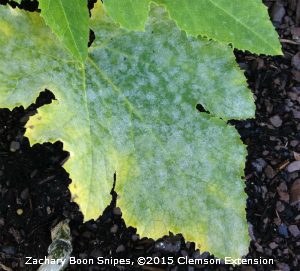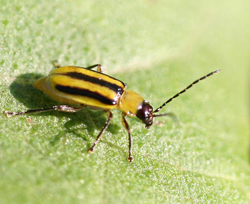No Teenie Zucchini
By Ray Novitske, Fairfax Master Gardener

Various cucurbits & squash
Squash originated in North and South American and was cultivated for food throughout both continents by Native Americans. Our current zucchini and summer squash are relatively new introductions. Zucchini was developed in Italy from seeds brought back from early European explorers like Christopher Columbus. The term zucchini comes from the Italian word zucca — pumpkin or squash — and zucchino — a small squash.

Female flower at end of zucchini
Like other members of its family, zucchini produces both male and female flowers, roughly in a ratio of 20 male flowers to each female. Female flowers are recognizable by the tiny zucchini between the flower and the stem. Pollen must be carried from the male flowers to the female flowers in order for the fruit to develop. That’s where the bees come in.
Virginia sees several problems that plague our zucchini crops — powdery mildew and insects including a beetle, the squash vine borer, and the pickleworm. Powdery mildew is a fungal disease that attacks almost any plant, but seems to like squash. It looks like a white or gray powder on the leaves, and usually attacks in the latter part of the growing season when temperatures begin to drop. You can easily spot it growing on the top of squash leaves.

Powdery mildew on squash leaf
The squash vine borers are probably the biggest threat to zucchini grown in Northern Virginia. These pests are moths, with about 1 inch long wingspans resembling paper wasps with a red orange body. They are members of the clearwing moth family, but are active during daylight. The moths lay their eggs on the leaves of squash plants. Caterpillars emerge and bore into the main stems, eating their way through the stems for several weeks. Visible damage is described as sawdust from the frass (or fecal matter) at the entry point to the stem. Soon the stem wilts and dies.

Squash Vine Borer moth
Insecticides can be used at the base of the plants to kill the borers before they enter the vines. An organic pesticide such as Kaolin clay is recommended as well as permethrin. Both can be applied up to the day of harvest. Note that insecticides can harm pollinators, so they should be applied to the base of the vines and at night when pollinators are not active. Once infected with the borers, a plant can sometimes be salvaged by cutting out the infected area and burying the remaining stem in moist soil to encourage new root development.

Striped cucumber beetle
Pickleworms are a threat late in the growing season but not every year. They overwinter far from Virginia in the Gulf States, and the adult moths gradually migrate northward each year. The migration is accomplished through several generations. The larval stage does the damage by burrowing into the zucchini squash itself. You will see round holes in the squash with frass nearby. Control can be achieved by applying Kaolin clay, pyrethrins, and insecticidal soap. Permethrin is another effective control for pickleworms.
With some work, pests on your home garden zucchini plants can be controlled without using harsh pesticides. Enjoying tender zucchini dusted with salt and spices on your backyard grille during the summer makes the effort worthwhile.
References
Vegetables Recommended for Virginia, Virginia Cooperative Extension
Cucumbers, Melons, and Squash, Virginia Cooperative Extension
Squash Vine Borer, Virginia Cooperative Extension
Pest Management Guide, Section 2 Home Vegetables, Virginia Cooperative Extension
Cucumber, Squash, Melon & Other Cucurbit Insect Pests, Clemson Cooperative Extension